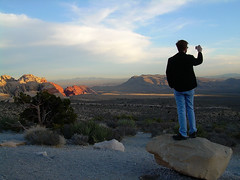 Shortly after visiting the Grand Canyon we took another long tour out into the Nevada countryside. This time, we were headed just a little West of Vegas to a place called “Red Rock Canyon”. As the name suggests, Red Rock is known for its colourful rock formations. The image on the right was taken by Sarah and it has to be one of my favourites. It’s not just because it shows my best side, either. I love how the red, green, yellow, brown, blue and white all draw your eye out to the vast expanse of countryside. This place was just as formidably beautiful, if not as breathtaking as the Grand Canyon.
Shortly after visiting the Grand Canyon we took another long tour out into the Nevada countryside. This time, we were headed just a little West of Vegas to a place called “Red Rock Canyon”. As the name suggests, Red Rock is known for its colourful rock formations. The image on the right was taken by Sarah and it has to be one of my favourites. It’s not just because it shows my best side, either. I love how the red, green, yellow, brown, blue and white all draw your eye out to the vast expanse of countryside. This place was just as formidably beautiful, if not as breathtaking as the Grand Canyon.
 Perhaps the most interesting part of the journey was the Calico Hills. These hills are actually petrified (or lithified) sand dunes or what’s commonly known as Aztec Sandstone. The image on the left shows one such outcropping. This sandstone owes its vibrant red and orange colours to oxidation (literally rust) that occurred over 250 million years ago (in the Mesozoic era). 180 million years ago these rock formations used to actually be free-flowing sand dunes. How did they turn to stone you ask?
Perhaps the most interesting part of the journey was the Calico Hills. These hills are actually petrified (or lithified) sand dunes or what’s commonly known as Aztec Sandstone. The image on the left shows one such outcropping. This sandstone owes its vibrant red and orange colours to oxidation (literally rust) that occurred over 250 million years ago (in the Mesozoic era). 180 million years ago these rock formations used to actually be free-flowing sand dunes. How did they turn to stone you ask?
 My understanding is that sand dunes behave in much the same way as water. They “flow” albeit slowly and they can leave a “sediment” behind. Over the millennia, the crushing weight of the sand dune itself can fossilize (or lithify) the sand underneath. The direction the dune was traveling and the way in which the layers are deposited by the wind all have a bearing on the formations. The image to the right shows the beautiful strata in some of this sandstone rock.
My understanding is that sand dunes behave in much the same way as water. They “flow” albeit slowly and they can leave a “sediment” behind. Over the millennia, the crushing weight of the sand dune itself can fossilize (or lithify) the sand underneath. The direction the dune was traveling and the way in which the layers are deposited by the wind all have a bearing on the formations. The image to the right shows the beautiful strata in some of this sandstone rock.
The Calico Hills can only really be appretiated as a panorama. See my Calico Hills Panorama here.
West of the hills is the canyon itself. We stood at the foot of the surrounding mountains, looking East towards the Vegas basin. Technically, the canyon forms part of the Mohave desert, so it’s quite barren with just a few Joshua trees and other desert-like shrubbery.